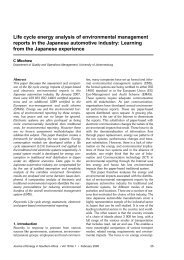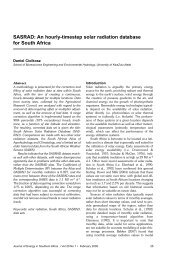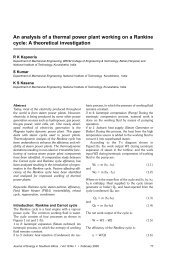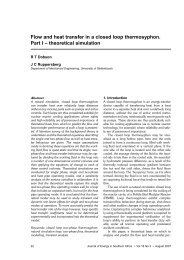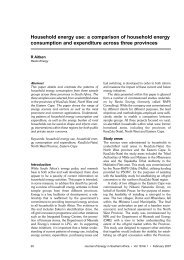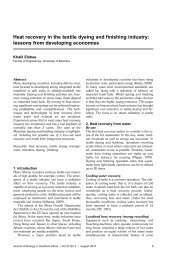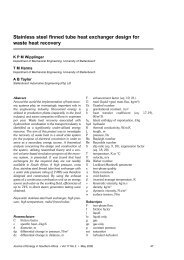Solar electrification by the concession approach in rural Limpopo ...
Solar electrification by the concession approach in rural Limpopo ...
Solar electrification by the concession approach in rural Limpopo ...
Create successful ePaper yourself
Turn your PDF publications into a flip-book with our unique Google optimized e-Paper software.
<strong>Solar</strong> <strong>electrification</strong> <strong>by</strong> <strong>the</strong> <strong>concession</strong> <strong>approach</strong> <strong>in</strong> <strong>rural</strong> <strong>Limpopo</strong> prov<strong>in</strong>ce 113.1.1 Light<strong>in</strong>g: Ma<strong>in</strong> fuels presently used and fuels households wouldlike to switch toSHS-owners predom<strong>in</strong>antly used <strong>the</strong>ir solar lights for light<strong>in</strong>g, but <strong>the</strong>y were apparently notsatisfied, because 76% preferred to switch to grid electricity, with only 2% preferr<strong>in</strong>g solar light<strong>in</strong>g.In contrast, 96% of grid-users used grid electricity for light<strong>in</strong>g, and none wanted to switch to solar.7% wanted to switch to paraff<strong>in</strong> light<strong>in</strong>g; probably believ<strong>in</strong>g this would lessen <strong>the</strong>ir electricity bills.Non-electrified households depended ma<strong>in</strong>ly on paraff<strong>in</strong> (63%) and candles (34%) for light<strong>in</strong>g, but,like <strong>the</strong> SHS owners, <strong>the</strong>y seemed unhappy, with 81% preferr<strong>in</strong>g to switch to grid electricity and noo<strong>the</strong>r fuel.3.1.2 Cook<strong>in</strong>g: Ma<strong>in</strong> fuels presently used and fuels households wouldlike to switch toSHS owners almost all cooked with wood (91%), with very limited use of gas and paraff<strong>in</strong> (6% and3% respectively). The majority preferred to switch to grid electricity for cook<strong>in</strong>g (77%) while 2%wanted to cook with solar. This preference for cook<strong>in</strong>g with solar <strong>in</strong>dicates that <strong>the</strong>se fewhouseholds did not fully understand <strong>the</strong> limitations of solar electricity for high power applications,unless <strong>the</strong>y were referr<strong>in</strong>g to solar <strong>the</strong>rmal cookers. Wood was also <strong>the</strong> major cook<strong>in</strong>g fuel for gridelectrified households, account<strong>in</strong>g for 71% of <strong>the</strong> households. 22% cooked with grid electricity and7% with paraff<strong>in</strong>. There was overall satisfaction with this fuel use pattern as evidenced <strong>by</strong> <strong>the</strong> smallpercentage of only 4% who wanted to switch cook<strong>in</strong>g fuel to fuelwood.Virtually all (99%) of non-electrified households cooked with wood; <strong>the</strong> rema<strong>in</strong>der used gas. Thepercentage want<strong>in</strong>g to switch to cook<strong>in</strong>g with grid electricity was similar to that for SHS-users, at78%. No o<strong>the</strong>r fuel was preferred for cook<strong>in</strong>g.It is worth not<strong>in</strong>g that while households without grid electricity strongly prefer it as a cook<strong>in</strong>g fuel,grid-users mostly cook with wood. This is generally because grid electricity is too expensive to cookwith. Households without grid electricity may not be aware of this constra<strong>in</strong>t, hence <strong>the</strong>ir preferencefor electric cook<strong>in</strong>g.3.1.3 Water heat<strong>in</strong>g: Ma<strong>in</strong> fuels presently used and fuels households would like toswitch toThe pattern among SHS-users for water heat<strong>in</strong>g fuels is quite similar to that for cook<strong>in</strong>g fuels. Wooddom<strong>in</strong>ates o<strong>the</strong>r fuels <strong>by</strong> a wide marg<strong>in</strong>: 83% compared to 11% and 5% for paraff<strong>in</strong> and gasrespectively. Aga<strong>in</strong> most SHS-users prefer to switch to grid electricity (75%) with 2% express<strong>in</strong>g apreference for solar water heat<strong>in</strong>g.Among grid-users, only 16% used electricity for water heat<strong>in</strong>g compared to 78% us<strong>in</strong>g wood and 2%us<strong>in</strong>g paraff<strong>in</strong>. There was also little desire to switch fuels among grid-users, with only 4% want<strong>in</strong>g toswitch to wood.The non-electrified households had <strong>the</strong> highest wood usage for water heat<strong>in</strong>g, 96% with 2% us<strong>in</strong>gparaff<strong>in</strong> and 1% us<strong>in</strong>g gas. The desire to use grid electricity was still very pronounced, with 76%wish<strong>in</strong>g to switch to grid electricity.3.1.4 Refrigeration: Ma<strong>in</strong> fuels presently used and fuels households would like toswitch toThere were only a few (two to three respondents) responses under refrigeration, and no respondentreported us<strong>in</strong>g any fuel for refrigeration, just preference for electricity (3%) and solar (2%). It wouldnot be useful to attach undue statistical significance to this relatively <strong>in</strong>significant number ofresponses.3.1.5 Media applications: Ma<strong>in</strong> fuels presently used and fuels households wouldlike to switch toSHS households predom<strong>in</strong>antly rely on <strong>the</strong>ir solar systems to power televisions and radios, with<strong>in</strong>significant use of car batteries (1%). The preferred fuel for power<strong>in</strong>g TVs was found to be onlygrid electricity. For radios, aga<strong>in</strong> <strong>the</strong> ma<strong>in</strong> fuel <strong>by</strong> far was SHS, at 87%, with m<strong>in</strong>imal use of carbatteries and dry cell batteries (2% <strong>in</strong> each case). The preferred fuels for radios were grid electricity(69%) and SHS (6%).ENERGY RESEARCH CENTRE





